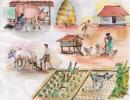
|
Introduction to Animal Husbandry
|
Introduction - Keeping Animals
Animal husbandry in organic farming is different from extensive animal husbandry, which is often environmentally damaging (e.g. through overgrazing of common lands), and from intensive animal husbandry which keeps animals under ethically unacceptable conditions.
- Farm animals can have many functions on a farm, but not all farms are suitable for keeping animals.
- Organic animal husbandry puts a central focus on the welfare and health of the animals.
- In order to obtain a sustainable farming system, it is crucial to select the right kind and number of farm animals.
- Sheds and beddings must be developed in a way to ensure the welfare and health of the animals.
Integrating animals into the farm
Integrating animals into a farm can help to recycle nutrients. By-products such as straw, biomass
from field margins or kitchen wastes, can be used as cheap and easily available fodder. At the
same time, the dung should be returned to the fields in the most efficient way in order to increase
the fertility of the soil. Animal products such as milk, eggs, and meat can both be used for home consumption in the family as well as for selling, thus generating additional income for the farmer. Integrating animals in the farm
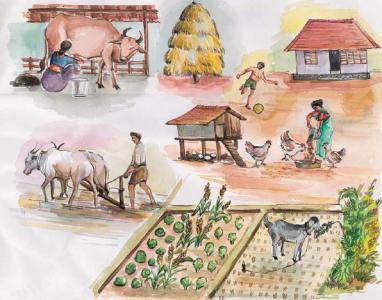 |
| Animals integrated into the farm, showing the flow of fodder, dung and products |
| © Ifoam Training Manual for Organic Farming in the Tropics |
Reasons to keep farm animals
 |
| A cow is not just a cow! Farm animals can have many functions for a farmer |
| © Ifoam Training Manual for Organic Farming in the Tropics |
- Yield products such as milk or eggs for sale or own consumption continuously
- Recycle by-products such as straw or kitchen waste
- Serve as draught animals for tillage or transport
- Produce meat, hides, feathers, horns etc
- Serve as an investment or a bank
- Produce dung which is of great importance for soil fertility
- Help in pest control (e.g. dugs) and weed management (e.g. grazing on barren fields)
- Have cultural or religious significance (prestige, ceremonies etc.)
- Produce young stock for breeding or sale
The significance of each role will vary from animal to animal and from farm to farm. It will also depend on the individual objectives of the farmer.
Making a decision on animal husbandry
 |
| Some questions to facilitate the decision on whether to engage in animal husbandry |
| © Ifoam Training Manual for Organic Farming in the Tropics |
Is my farm suitable? Do I have sufficient space for shedding and grazing, sufficient fodder or by-products to feed, sufficient know-how on keeping, feeding, and treating the specific kind of animals?
Will the animals benefit my farm? Can I use the dung in a suitable way? Will I get products for my own consumption or sales? Will the animals somehow affect my crops?
Can I get the necessary inputs? Is sufficient labour available within or outside my farm? Is enough fodder and water of good quality available throughout the year? Will remedies and veterinary support be available, if needed? Can I get suitable breeds of animals?
Will I find a market for the products? Does anyone want to buy my milk, eggs, meat etc.? Is the price worth the effort? Am I able to compete with other farmers?
Requirements of Farm Animals
What animals need
Organic farmers try to achieve healthy farm animals which can produce satisfyingly over a long
period of time. To achieve this goal, various needs of farm animals have to be considered:- Fodder in adequate quality and quantity: organic and without pesticide-residues; for non-ruminants: diversity in fodder is usually required
- Sufficient access to clean drinking water
- Clean sheds of sufficient size and with adequate light and fresh air
- Sufficient freedom to move around and perform their natural behaviour
- Healthy conditions and veterinary follow up, if needed
- Sufficient contact with other animals, but no stress due to overcrowding
- For herd animals: an appropriate age and sex distribution within the herd
What farm animals need: for example chicken
 |
| Chicken have various needs which should be fulfilled simultaneously |
| © Ifoam Training Manual for Organic Farming in the Tropics |
How many animals to keep?
In order to identify the appropriate number for a specific kind of animal on a farm, the following
points should be considered:- Availability of fodder on the farm, especially in periods of scarcity (e.g. dry season)
- Carrying capacity of pastures
- Size of existing or planned sheds
- Maximum amount of manure the fields can bear
- Availability of labour for looking after the animals
In tropical countries, farm animals are frequently found to be underfed. When defining the number of farm animals, keep in mind that the economical benefit will be higher when fewer animals are kept, but fed well. Not only the amount, but also the quality of the available food must be taken into consideration.
What the IFOAM Basic Standards say on animal husbandry
Organic animal husbandry means not only feeding organic food and avoiding synthetic food additives,
but also putting a focus on satisfying the various needs of the farm animals. Good health
and welfare of the animals are among the main objectives. Suffering due to mutilations, permanent
tethering or isolation of herd animals must be avoided as much as possible. For various reasons,
landless animal husbandry (i.e. fodder purchased from outside the farm, no grazing land)
is not permitted in organic farming.There is a range of standards regulating the management, shedding, feeding, veterinary treatment, breeding, purchase, transport, and slaughter of farm animals in detail. Some of the most important standard requirements are listed below.
Ifoam Standards for Animal Husbandry
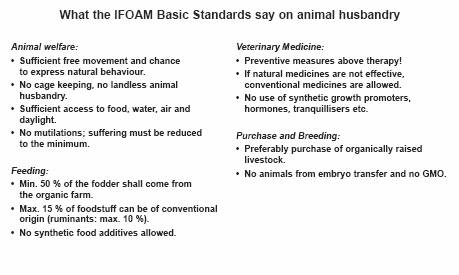 |
| Some important requirements of the IFOAM Basic Standards referring to animal husbandry |
| © Ifoam Training Manual for Organic Farming in the Tropics |
Housing
Planning sheds
With the exception of nomadic lifestyles, most farm animals are temporarily kept in sheds. The
combination of animal husbandry and farm activities requires control of their movements so as
to avoid damage to crops. For the welfare and health of the animals, sheds must be cool and
aerated, and protect from rain. They should be constructed in a way ensuring:
- Sufficient space to lie down, stand up, move and express natural behaviour (e.g. licking, scratching etc.)
- Sufficient light (as a rule, one should be able to read a newspaper in the shed)
- Protection from sunlight, rain, and extreme temperatures
- Sufficient aeration, but no draught
- Appropriate beddings (see section below)
- Elements to exercise natural behaviour (e.g. for poultry: perching rails, sand baths and secluded laying nests)
- Sheltered pits or heaps to collect and store manure
For economic reasons, sheds can be built with simple, locally available materials. Many countries have a rich tradition of shed constructions, and have developed the most efficient and appropriate shed systems for the conditions of the region. If techniques of this heritage are combined with the above principles, a locally adapted and at the same time animal friendly system may be obtained.
Sheds for farm animals
 |
| Traditional simple sheds in Senegal: cattle shed, goat shed, chicken shed |
| © Ifoam Training Manual for Organic Farming in the Tropics |
Beddings
Beddings are materials used in sheds for keeping the floor soft, dry, and clean, which is important
for animal health. They absorb the excrements of the animals and need to be replaced from
time to time. Beddings can be of straw, leaves, twigs, husks or other locally available material.
They can be replaced daily or kept for several months while adding fresh material on top.
Feeding animals
- A diverse and balanced mixture of food is a pre-condition for good animal health.
- Grazing and shed feeding both have their advantages as well as disadvantages.
- Fodder cultivation can be integrated into the farm without too much competition with crop production.
- Overgrazing is a major threat to soil fertility.
A balanced diet
Food requirements of animals
If farm animals are to be productive (milk, eggs, meat etc.), it is important that they get suitable
food in sufficient quantities. If the fodder production of one's farm is limited (which usually is the
case), it might be economically valid to keep less animals but supply them with sufficient food.
The appropriate quantity and the mix of feed items will of course depend on the type of animal,
but also on its main use (e.g. chicken for meat or egg production, cattle for milk, meat or draft
etc.). In milk production for example, cows producing milk should be given fresh grass and possibly
other feed items of sufficient protein content. On the same diet, draught animals would
rapidly become exhausted.A balanced diet will keep an animal healthy and productive. Whether or not a farm animal receives the appropriate amount and kind of fodder usually can be seen by the shine of its hair or feathers. For ruminants, a majority of the fodder should consist of roughage (grass, leaves). If concentrates or supplements are used (e.g. agricultural by-products and wastes), they should not contain growth promoters and other synthetic substances. Instead of buying expensive concentrates, there are a variety of leguminous plants rich in protein which can be grown in the farm as cover crop, hedges or trees. If mineral content in the available fodder is not sufficient to satisfy the animal's requirements, mineral salt bricks or similar feed supplements can be used as long as they do not contain synthetic additives.
Fodder cultivation
Grazing or shedding?
In many regions of the tropics, favourable periods with abundant fodder alternate with less favourable periods when there is almost nothing to feed to the animals. But keeping animals means providing fodder throughout the year. Fodder can be produced on the farm as grazing land or as grass or tree crops used for cutting. While grazing requires less labour than shed feeding, more land is needed and appropriate measures to keep the animals away from other crops must be undertaken. Grazing may lead to a lower productivity (milk, meat) but usually is the more favourable option concerning health and welfare of the animals. Shed keeping, however, has the advantage that the dung can be easily collected, stored, or composted and applied to the crops. Whether grazing or shed feeding is the more suitable option will mainly depend on the agro-climatic conditions, the cropping system, and the availability of land. A combination of shed feeding and grazing in a fenced area may be an ideal combination of high productivity and animal friendly husbandry. In extensive grass lands of semi-arid areas, however, grazing may be the only suitable option.
Grazing versus shed feeding
 |
| The pros and cons of grazing and shed feeding, and the combination of both systems as a promising option |
| © IFOAM Training Manual for Organic Farming in the Tropics |
Integrating fodder cultivation in the farm
In most smallholder farms, fodder cultivation will compete for space with the cultivation of crops.
Whether fodder cultivation (and thus animal husbandry) is economically more beneficial compared
with crop production must be assessed case by case. However, there are some options for
integrating fodder crops in farms without sacrificing much land. Below are some examples:
- Grass or leguminous cover crops in tree plantations
- Hedges of suitable shrubs
- Shade or support trees
- Grass on bunds against soil erosion
- Grass fallows or green manures in the crop rotation
- Crops with by-products such as paddy straw or pea leaves
Pasture management
The management of pastures is crucial for a good herd management. It is also important to practice appropriate management throughout the year. There are many different types of grasses, and every climatic region has grasses which are specifically adapted to the conditions. In some cases it may be worth considering to till the grazing site and sow grass varieties that are more appropriate to the animal's needs.
Overgrazing is probably the most significant threat to grass land. Once the protective grass cover is destroyed, the top soil is prone to erosion. Degraded pastures or land with little plant cover is difficult to re-cultivate. Therefore, it is important that the use and intensity of grazing on a particular piece of land is appropriate to its production capacity. Sufficient time must be given to a pasture to recover after intensive grazing. Fencing off of areas and rotation of the grazing animals on several pieces of land is a suitable option. This will also reduce infection from parasites encountered while the animals graze.
The intensity and timing of grazing as well as the cutting of the grass will influence the varieties of plants growing in the pasture. If certain weeds are a problem, the organic farmer will have to change his management practises as weedicides can not be used.
Rehabilitation of pastures
Rehabilitate pasture land with improved grass varieties and legumes for higher yield, higher nutrive value and palatability. Grasses can be transplanted or grown from seed. Legume seeds are sown between grass lines. Multipurpose trees can also be planted to provide fodder, fuel and timber.
Keeping animals healthy
Disease causing germs and parasites are present almost everywhere. Like humans, animals have an immune system which is usually able to cope with these germs. And as with humans, the efficiency of the immune system will be disturbed if animals are not properly fed, can not practise their natural behaviour, or are under social stress.
Health is a balance between disease pressure (the presence of germs and parasites) and the resistance (immune system and self healing forces) of the animal. The farmer can influence both sides of this balance: reduce the quantity of germs by maintaining good hygiene, and strengthen the animal's ability to cope with germs.
Organic animal husbandry puts its focus on improving the living conditions of animals and on strengthening their immune systems. Of course: if an animal gets sick it must be treated. But the farmer should also think about why the immune system of the animal was not able to fight the disease or the parasite attack. And the farmer should think of ways to improve the animals living conditions and hygiene in order to strengthen it.
Factors influencing animal health
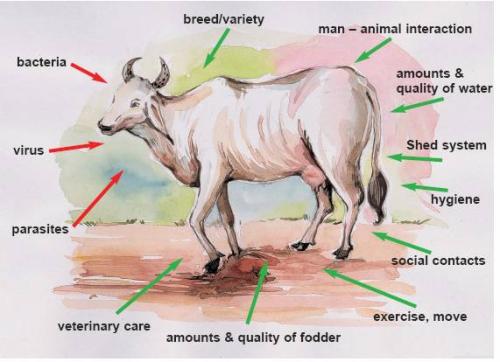 |
| Bacteria, viruses and parasites attacking the farm animal which fights back with its immune system. The farmer can influence both sides of this balance |
| © Ifoam Training Manual for Organic Farming in the Tropics |
Prevention before curing
Similar as in crop health, organic animal husbandry puts the main emphasis on preventive measures in order to keep animals healthy, rather than on curative methods. This starts from keeping robust breeds rather than high performing but verysusceptible ones. Next, the conditions in which the animals are kept should be optimal ones: sufficient space, light and air, dry and clean bedding, frequent exercise (e.g. grazing) and proper hygiene etc. The quality and quantity of fodder is of crucial importance for the health of the animal. Instead of feeding commercial concentrates which make animals grow faster and produce more, a natural diet appropriate to the requirements of the animal should be achieved.
Where all these preventive measures are taken, animals will rarely fall sick. Veterinary treatment thus should play only a secondary role in organic farming. If treatment is necessary, alternative medicine based on herbal and traditional remedies should be used. Only if these treatments fail or are not sufficient, synthetic medicines (e.g. antibiotics) may be used.
Prevention before curing
 |
| Only when all preventive measures fail animals should be treated with alternative remedies |
| © Ifoam Training Manual for Organic Farming in the Tropics |
Veterinary treatment
get to know the causes of (or factors that favour) diseases in order to enhance the natural defence mechanisms of the animal (and to prevent its manifestations in the future, see above)
What the IFOAM Basic Standards say on veterinary medicine
Unlike in crop production, synthetic means are allowed to cure sick animals if alternative treatment
is not sufficient. Here, reducing the suffering of the animal is given priority over the renunciation
of chemicals. However, the standards clearly demand that priority is given to management
practices which encourage the resistance of the animals thus preventing the outbreak of a disease.
Therefore, an outbreak of a disease shall be considered as an indicator that the conditions under which the animal is kept are not ideal. The farmer should try to identify the cause (or causes) of the disease and prevent future outbreaks by changing management practises.
If conventional veterinary medication is applied, withholding periods must be adhered to before the animal products can be sold as "organic". This shall ensure that organic animal products are free from residues of antibiotics etc. Synthetic growth promoters are not allowed in any case.
IFOAM Basic Standards on veterinary medicine
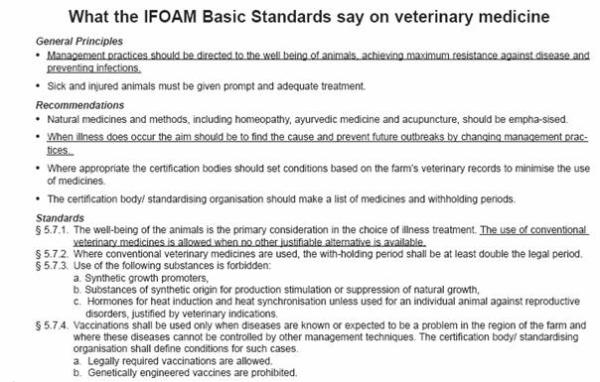 |
| Statements of the IFOAM Basic Standards on Animal Health (Edition 2000). Sections of specific relevance in this context are underlined |
| © Ifoam Training Manual for Organic Farming in the Tropics |
Controlling parasites with herbal remedies
Herbal medicines are widely used in many countries. Some traditional farming communities have
a vast knowledge of local plants and their healing properties. Plants can definitely support the
healing process, even if they do not eliminate the germ of the disease directly. Still, farmers
should not forget to identify the cause of the disease and also to re-think their management practises.
For parasite problems, changing the living conditions or the management of pastures will
be more effective in the long run than any treatment.Breeding in Organic Animal Husbandry
As preventive measures for maintaining good animal health are of high relevance in organic farming, the selection of breeds suitable to local conditions and to organic feeding is of crucial importance. This requires that suitable breeds are available. Traditional breeds of farm animals may be a good starting point for organic animal breeding. Animals can be improved by selection of individuals especially suitable for organic conditions. They can be crossbred with suitable new breeds, thus achieving an animal with the positive aspects of traditional breeds and the satisfying production of the new breeds.
For breeding, organic farming uses natural reproduction techniques. While artificial insemination is allowed, embryo transfer, genetic manipulation, and hormonal synchronisation are not permitted according to IFOAM standards.
Breeding Goals
Over the last decades, traditional breeds have been replaced by high performing ones in many regions. Similar to high yielding plant varieties, these new breeds usually depend on a rich diet (concentrates) and optimal living conditions. As high performing breeds in general are more susceptible to diseases than traditional varieties, they need frequent veterinary interventions. Thus, these new breeds might not be the right choice for small farmers, as the costs of food concentrates and veterinary treatment are too high compared with what can be earned by selling the products.
In addition, for organic farmers the main animal product (e.g. milk) is not the only reason to keep animals. Breeding activities therefore should try to optimise the overall performance of the animal, taking into consideration the different goals of an organic farmer. For example a poultry breed suitable for organic smallholder farms might not be the one with the highest egg production, but one in which meat production is good, and kitchen wastes and whatever is found on the farm yard can be used as feed. Suitable cattle breeds would produce sufficient milk and meat while feeding mainly on roughage and farm by-products (e.g. straw), be of high fertility and good resistance against diseases, if required, they can also be used for draught and transport.
 |
Maximum performance or life production?
When comparing the production of different breeds of cows, usually, only the production per day or year is taken into consideration. However, high performing breeds usually have a shorter life span than traditional ones with lower production. The life milk production of a cow giving, for example, 8 litres per day, but over 10 years, therefore would be greater than the one of a highbreed cow yielding 16 litres per day, but dies after 4 years. As the investments to get a milk producing cow are quite high, i.e. the rearing and feeding of a calf or the purchase of an adult cow, continuous production over a long life span should be of high interest to the farmer. This should be reflected in the breeding goals, which so far mainly focus on the maximum short term production.
 |
Animal Welfare in Organic Agriculture
Animal welfare is to note that animals have experiences and are sentient beings. This gives humans a moral obligation to treat animals well and to prevent that they suffer or die. To avoid suffering is both important in organic and conventional animal husbandry, but the organic principles go further than animal welfare. One of the basic principles in organic farming is to allow animals to behave naturally. But just allowing animals to express natural behaviour does not guarantee their welfare. In fact, natural behaviour can sometimes reduce welfare. For example, the escape behaviour of a hen in response to a predator (e.g. a fox) and the wallowing by bigs when hot, are both natural behaviour. However, it would not be in the best interest of these animals to expose them to these conditions just so they can show their natural behaviour. Thus the absence of a wallow where the temperature is controlled is not a problem, but it becomes a problem if the temperature rises.
Cattle:
Living in groups is a basic characteristic of cattle, a social species, and can only be fulfilled by keeping them loose housed. Tied cattle are very restricted in their behaviour, which has negative consequences on health. If cattle are kept on pasture, shelter should be available to protect them from sun during hot periods, and from rain and wind during cold. Trees can serve to give shade and protection in summer. During the winter in temperate and cold areas, free-range cattle need at least a dry lying area with protection against wind. In wet areas, this can only be offered by a roofed area. A cause of behavioural problems and inconveniences in cattle is bad handling. Research has developed some general rules how to reduce the animals' fear of humans and improve the ease of handling. All cattle can be taught to be easy to handle and not to be frightened or attack defensively. For example, it is important to teach bulls acceptable behaviour as calves. Individually reared bulls were found to threaten and attack humans more than those reared in groups. If you treat your cattle well, they will be easier to handle. Avoid shouting and hitting as it will lead to a higher level of fear from humans and more animals attacking humans.
Pigs:
Apart from adult boars and sows around farrowing, pigs are social animals and should be kept in groups. Their natural groupings are small and stable. In commercial productions pigs are usually kept in larger groups and repeatedly mixed with unfamiliar individuals. Problem arises from disrupting social bonds. Thus, mixing of pigs should be avoided whenever possible. Pigs should be allowed to eat simultaneously. If their feed is restricted, each pig should have sufficient space at the through.
Floors should be bedded with straw or similar material. Bedded flooring not only improves comfort, but also allows the pigs to investigate and manipulate the material, reducing destructive behaviour against other pigs such as tail biting.
Special emphasis should be given to the housing of farrowing and lactating sows. To enable them to turn around, to perform nest-building behaviour, to separate their dunging area from their lying area and to prevent piglets from being crushed, sows must be allowed a minimum space of 7.5 m².
Poultry (Laying Hens):
Laying henns have a daily rhythm of food intake, therefore feed should be plentiful especially in the late daytime hours. A scratching area with adequate litter is important for the welfare of laying hens, it also helps to prevent feather pecking. Long straw seems to be the most suitable material for foraging, scratching and pecking. Also, giving hay, silage and other materials (e.g. pecking stones), as well as scattering grain, allows foraging and keeps the hens busy. Laying hens should have access to an outdoor run that also provides foraging possibilites. In outdoor runs, hens can take in a lot of fresh plant matrial. The run should also be equipped with cover, such as trees and bushes to provide hiding places and shade. To prevent an excessive use oth the vegetation and accumulation of nutrients, a rotation system must be used (at least to runs of 4m² each), thereby also reducing the risk of parasitic infection. A separate large box with sand should be present in the hen house or the outside run to allow dust bathing. Perches are a preferred site for laying hens to preen, but also for rosting and sleeping, especially at night.
Information Source Links
- IFOAM Training Manual for Organic Agriculture in the Tropics
- Vaarst, M; Roderick, S.; Lund, V. et al. (2004): Animal Health and Welfare in Organic Agriculture, CAB International, Wallingford, UK.

 Back
Back
